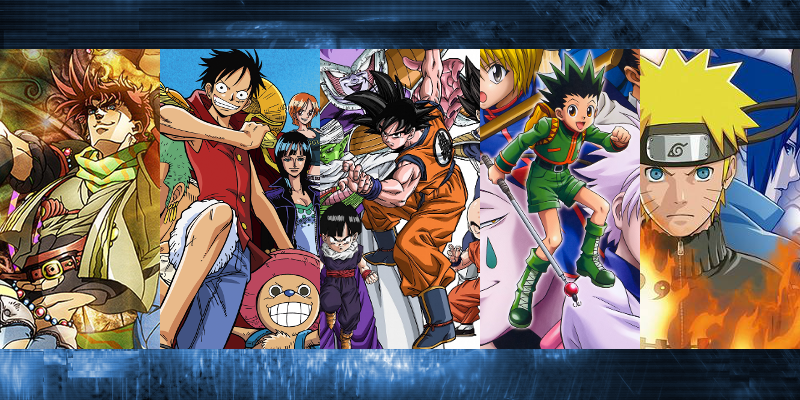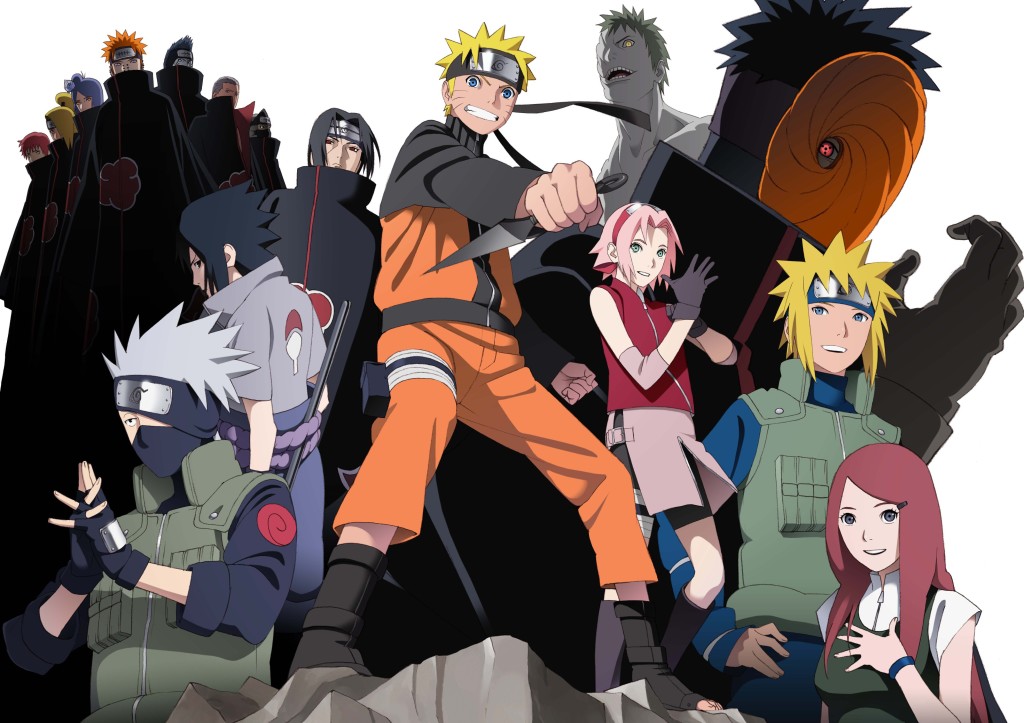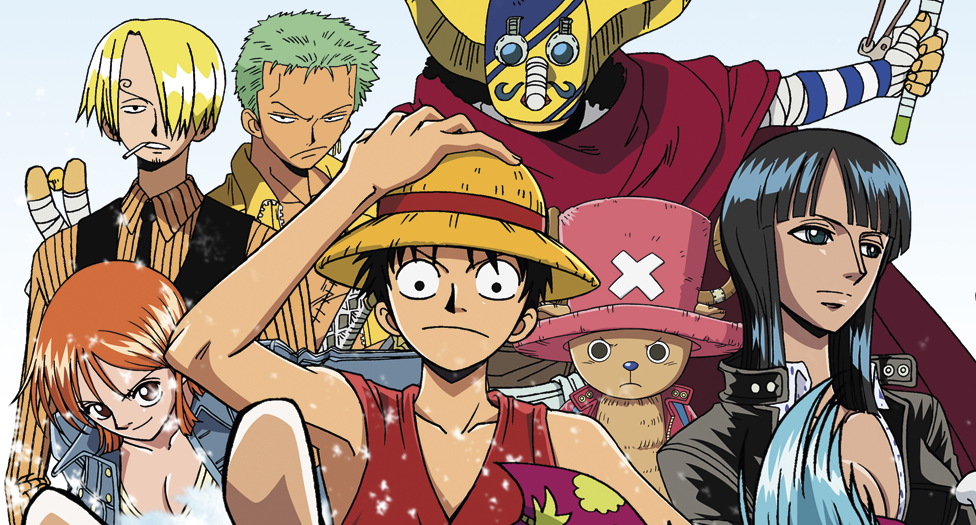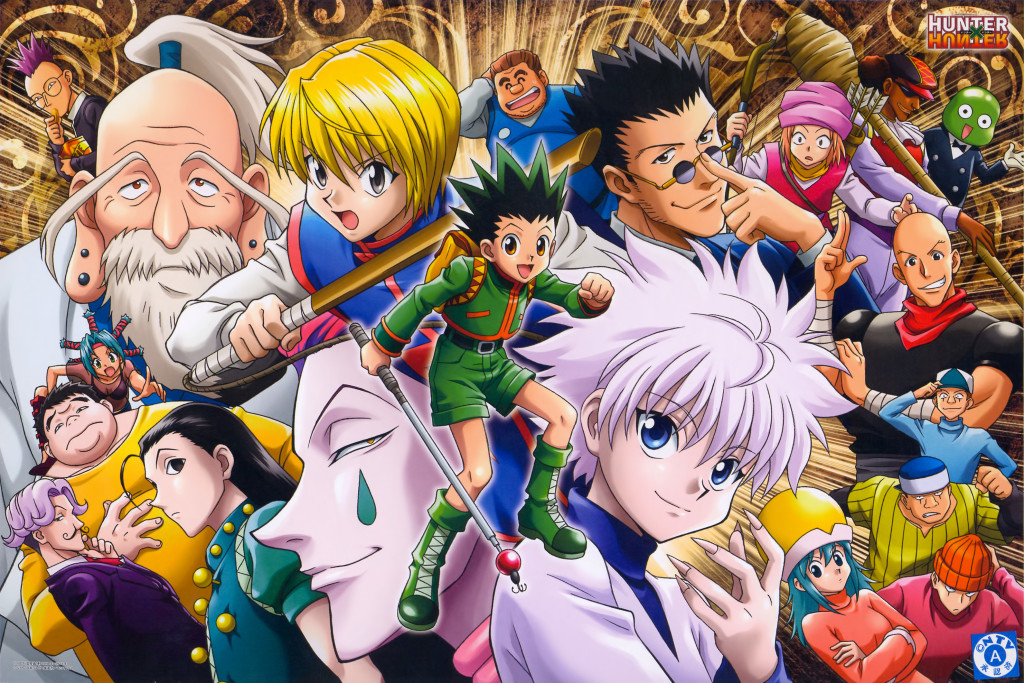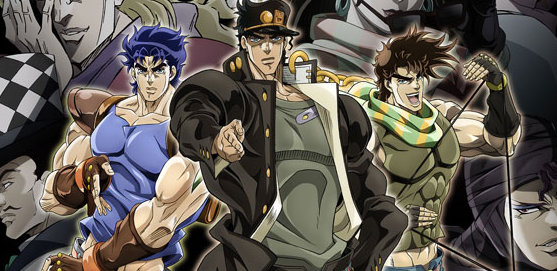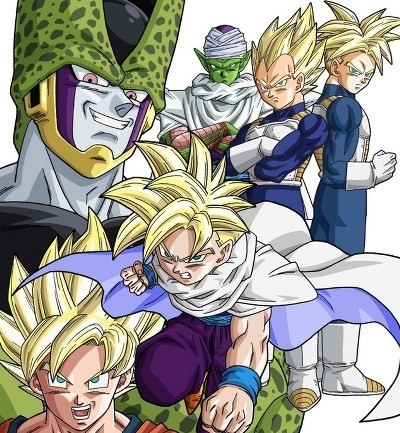Now that there are currently four, soon to be five, long running Shōnen Jump series airing on Toonami together, I have to admit the line-up can seem rather monotonous. All of these series are cut from a similar cloth but I am getting real tired of seeing people regurgitate the point that they’re all the same show. They share similar tropes to be sure. Each have long multi-part fights and some amount of training between them, expansive story arcs, moral fiber and an emphasis on fighting for your friends or family. However, each also have unique qualities that set them apart from one another. Allow me to take the time to describe where I believe they differ.
In the Toonami run of Naruto Shippuden, the current goals are to bring Sasuke back to the village and defeat the Akatsuki organization, which are trying to use the power of the tailed beasts. Perhaps more so than any other hero in these shows, Naruto is out to prove himself. His motivations are to be acknowledged by the village as a person rather than a monster and to keep his promise to bring Sasuke home. Rivalry and legacy are a big part of Naruto. We see history repeat itself over generations. On the action side of things, battles in Naruto tend to be on the more calculated side and involve various tactics and special techniques. Eventually power-ups somewhat diminish that aspect but it still remains part of the formula. While there is some juvenile humor the story tends to take itself seriously more often than not. Despite the conflicts being on a somewhat smaller in scale than say Dragon Ball Z, there is always a sense of urgency in a Naruto battle. Filler episodes tend to fall into the common scenario of Naruto and other Leaf ninja assisting another village or group via a ranked mission. A lot of those try to relate back to Orochimaru in some way or give Naruto a reason to relate to another character to go for an emotional connection. It has a tendency to repeat itself a lot in filler but sometimes those mini arcs break convention and at least highlight other characters than the core group. Much of the world of Naruto has not yet been seen so the majority of the stories take place around Hidden Leaf Village and its neighboring territories. This doesn’t offer a great variety honestly so the fights often take place in forests or flat battlefields. I believe a big part of what draws people to Naruto is the visual style of the characters and setting. It largely avoids getting super deformed except for the occasional comedy bit. And it stays on model other than the fights with very fluid animation sacrificing the model for fluidity. Allow me to show my age when I say, Naruto is hip with the kids.
In One Piece, Luffy’s goal is of course to obtain the one piece and become king of the pirates but that’s not about acknowledgement so much as just something he wants to do. Luffy is a goof ball who doesn’t take most situations seriously unless absolutely necessary. Zoro wants to defeat Mihawk to prove he is the greatest swordsman, Sanji wants to find an ocean called the All Blue, Nami wants to make a map of the world and Robin is looking for the lost history of the world. Those goals are touched on from time to time but most of the series does not focus on those goals but rather dreams in general. For the most part, the crew goes from place to place seeking adventure as they travel the grand line and often help groups or individuals along the way. In One Piece there is a tremendous focus on the value of comrades and following your dreams as well as defining justice. Even the villains have dreams. The battles in One Piece differ depending on who is fighting. Luffy, Sanji, Franky and Zoro tend to go all out using their signature techniques because they are physically strong. When they fight, Nami and Usopp have to use their wits and cunning and usually a decent amount of luck while Robin and Chopper make use of their unique abilities. Training is not seen much at all in One Piece so the characters tend to introduce new techniques in the middle of a battle. Some may find that too convenient as the heroes tend to have some way deal with any situation and we don’t often see the process of them learning a new skill. The tone of One Piece is on the light side most of the time and the visuals are bright and cartoonish. One Piece doesn’t tend to take itself seriously very often but it balances that with some heartfelt drama. It’s the sappiest of these five shows because the characters wear their emotions on their sleeves and are anything but reserved. Like with Naruto, the filler episodes often involve one-off characters getting assisted by one or more of the Straw Hats. Thankfully at this point there is not much of that anymore. The world of One Piece is massive and ever growing and the formula allows for all manner of settings. Small villages, Marine bases, haunted mansions, sea restaurants, vast deserts, snowy islands, cities above the clouds, you name it. The central antagonist is the World Government. Among these series, One Piece is the only one of the five where the bad guys ought to be the good guys. It is an interesting twist from the usual good versus evil scenario and plenty of people appreciate a well written story about rebelling against the establishment. The Straw Hats don’t pillage or do harm to innocent people and have done a lot of good on their journey they’re still outlaws who have pushed back against the World Government. Because corruption runs rampant within the World Government, the Straw Hats can be looked at as heroes despite having bounties on their heads. Above all else it’s the silliest of these five series and somewhat subverts situations you might find in Naruto, Hunter x Hunter or Dragon Ball Z. If you come into One Piece looking for laughs, you won’t be disappointed.
People joke about how much of Hunter x Hunter is borrowed by Naruto and I can’t help but note the similarities between the Hunter Exam and the Chūnin Exam but those stories were present in Naruto long before Shippuden. Really the only remaining similarity to what is present in Shippuden is Kurapika seeking revenge for his clan. Gon’s motivation is to become a hunter and find his father while Leorio’s is to become a hunter to be able to make enough money for medical school. Kurapika is of course out to become a black list hunter so he can avenge his clan but Killua is just doing the exam for fun. Toonami is knee-deep in the Hunter Exam at the moment but you’ll find that HxH changes things up with every arc. In that respect it’s only matched by JoJo’s Bizarre Adventure. The story deals quite a bit with Killua’s family who are assassins by trade and want Killua continue the family business. We’ll be hearing more about the Phantom Troupe in due time as well. There haven’t been any particularly long fights in HxH yet. So far Gon has made good use of his instincts to get out of scrapes. Being the youngest of the heroes in these five shows he’s got the biggest learning curve and we have already seen his ability to grow and adapt to situations. While Luffy is frankly a man child and Naruto is still a bit immature, Gon is the right age to be amazed by every little thing he sees in the world, especially since he was sheltered for so long. Kurapika, Leorio and Killua are all knowledgeable in their own ways and can get put off by Gon’s naivety but also appreciate his childlike qualities. We haven’t seen that much of the world of Hunter x Hunter but there is good variety in locations where the arcs take place which allows for scenarios that aren’t common in the other four series. Tone wise, HxH has been relatively light so far despite quite a lot of death but eventually it reaches a level of brutality unlike any of the others. For the moment, it offers the most even balance of adventure, comedy and drama out of the five.
JoJo’s Bizarre Adventure chronicles the generational battle of the Joestars and Dio. Each part of the story plays out a bit differently but they mesh together as a whole continuous narrative. Phantom Blood focuses on the rivalry of Jonathan Joestar and Dio. As Dio grows in power Jonathan must discover a way to defeat him when conventional strength and skill isn’t enough. Those fights are pretty straight forward power battles that are quite exciting. In Battle Tendency, Joseph Joestar fights to protect the world from the ancient warriors that originated the power Dio eventually gained. Joseph has to use his charisma, cunning and skill to outwit seemingly invincible adversaries. Those fights keep you guessing exactly who has the upper hand and often involve mind games. In Stardust Crusaders, Joseph and his Japanese grandson Jotaro develop unique powers call Stands. Over the course of the long arc they battle many other Stand users, each with individual quirks. Geologically JoJo’s goes all over the map starting in Europe then heading to the US, Japan, Egypt and other parts of the world. It is a globe-trotting adventure set in the real world unlike the other four series. While JoJo’s is incredibly over the top it also takes itself seriously most of the time. This makes for a lot of absurd situations but unlike One Piece where absurdity is played for laughs JoJo’s keeps a straight face offering a different sense of humor. I don’t want to go into any greater detail with JoJo’s but I’d argue it’s the series that is the least like the rest of these four due to setting, visual style, constantly changing narrative and hefty use of American pop culture. While One Piece has some characters inspired by real life American performers, JoJo’s name drops celebrities and song titles for characters, attacks and Stands. It’s all in good fun of course and it does not feel out of place. That element gives JoJo’s something unique to hook viewers with.
Dragon Ball Z is the show where the stakes couldn’t be higher. Nearly every battle is to protect a planet from destruction or save the inhabitants of a doomed planet. Granted the dragon balls cheapen death considerably but there’s always a reason for the heroes to feel like they have the weight of the world on their shoulders. Unfortunately that adds to the problem of Dragon Ball Z constantly repeating itself. The latest big bad shows up and defeats the heroes or a greater threat looms so they train and prepare for a rematch or the next big bad. Somebody dies so they obtain the dragon balls with a little or a lot of effort depending on what the narrative calls for. Rinse and repeat. Goku tends to get all the big wins or at least takes part in them. DBZ is straight forward and simplistic. I would not say the characters are shallow but they do lack some depth compared to the series that came after it. It is without a doubt the most nostalgic of all of these series and because of nostalgia a lot of the its’ shortcomings are forgiven. Even so, the characters and battles hold up well against their contemporaries. DBZ is the only series of the five that makes use of outer space and goes to other planets but despite that there is not a great deal of variety in where battles take place. On top of that, many of the fights feel similar due to enemies with multiple transformations. However, DBZ is also the only series of the five where multiple characters can fly and do battle in the air. There is something undeniably awesome about that aspect of the duels in Dragon Ball Z that the power fights in the other four series cannot match because they are literally grounded. Some of the other series have characters that can briefly battle while in the air but DBZ has so much more freedom in that realm. Character wise, the motivations in DBZ are rather basic. The antagonists seek greater power and aim to rule the universe. It is a lot like silver age American super hero comics in that respect. Saiyan warriors love to test their strength and are always itching for a fight. That makes Goku’s lot in life to find a worthy opponent. Goku shares this aspect with Vegeta but Goku fights for fun while Vegeta fights out of pride and a superiority complex. The rest of Goku’s friends are fighting to stay alive and protect their loved ones. Unlike the Straw Hats, Gon and company or Naruto’s squad they’re not motivated by acknowledgement, achievements, vengeance or anything beyond staying alive unless there’s a tournament to win. While Dragon Ball Z looks a bit cartoonish it largely takes itself seriously outside of some humor here and there. That’s an aspect a lot of viewers like because despite the dragon balls negating consequences there’s always weight behind the battles. Even though the story is very formulaic it always delivers an exciting confrontation and that is why this O.G. remains the champ in the hearts of many Toonami viewers.
While I will never deny that these shows have a great many things in common they all offer their own spin on those tropes and differ in look, tone, story structure, character motivations, variety of locations, types of battles and central themes. Personally, I get something different out of watching each of them. Given that most of them ran side by side in the same magazine in Japan and the US for many years without readers growing tired of them, I see no reason to believe Toonami cannot do the same with these series. Toonami has regularly had a high percentage of its air time comprised of these types of shows even when they were only airing a few shows a week. They’re popular series with long legs that have become an important part of the Toonami formula over the years. They must differ enough in key areas given that many viewers do not enjoy all five. I believe each of these series is worth Toonami’s time and should be allowed to reach a broader audience, so while I do not like them all equally by a long shot I am glad Toonami has chosen to air all five simultaneously rather than put some of them on the backburner. Though it is entirely possible we won’t see beyond the Cell Saga of Dragon Ball Z Kai for now and JoJo might air with breaks between seasons so the amount of time all five will be airing together may be 3 to 6 months. Whether all five of them air together throughout the next couple of years or not, I’m confident the Toonami audience will not get bored of these series.
I don’t believe airing them all together will cause a decline for Toonami much less put them on the road to cancellation. Rather, I see Toonami using these series to maintain stability regardless of whatever else they air in the coming years. I trust they have not grown complacent and the decision to acquire all of these series over the past four years is part of their long term plans. Nothing in television is a certainty so if you enjoy any of these shows, just be happy Toonami is airing them and not worry so much about what else they’ll be able to air. If you don’t like some or any of them, consider that someone else does and that’s why these shows are airing. If you feel Toonami has nothing for you because they are airing all of these shows and not something else, that’s unfortunate but they can’t meet the interests of every individual. They’re trying to entertain as many people as possible and these shows have their followings for a reason. Lastly, if you are a devoted fan of any of these shows, take the criticism they receive from other viewers in strive and keep debates civil. Everybody likes different things for different reasons. Respect your fellow Toonami viewers even if you’re not the one who drew first blood. We’re gonna have this line-up for a long time barring unforeseen circumstances so let’s try to maintain the peace and not let infighting among fanbases rage on.
I hope I adequately explained the differences between these five series. I’m not well versed on all of them and did not want to bring up future events and spoil surprises. If you felt I missed anything or if you disagree with my observations, feel free to respond in the comments section below. Thank you for taking the time to read my thoughts on this subject and continuing to support Toonami with your viewership.

